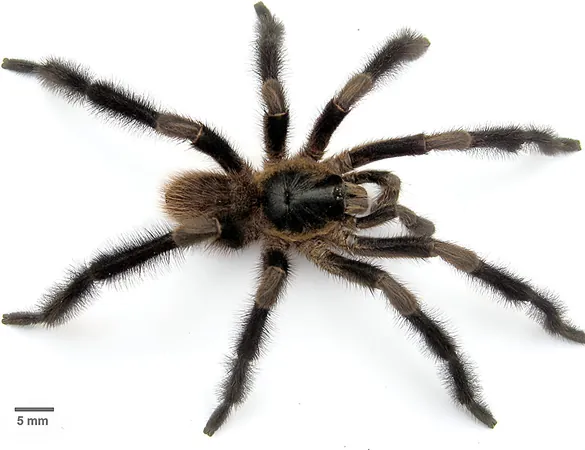
Meet the Enigmatic Trichopelma grande: The Giant Tarantula with Feather-Duster Legs Found in Cuba!
2024-11-24
Author: Jia
Cuba is not only famous for its vibrant culture and stunning landscapes but also for its unique wildlife, which continually dazzles researchers and nature enthusiasts alike. Recently, scientists have unveiled a remarkable new species of tarantula within the lush ecosystems of western Cuba, adding a new entry to the fascinating tapestry of arachnids on the island.
A New Obsession: Trichopelma grande
The newly identified tarantula, named Trichopelma grande, is making waves in the scientific community. Discovered by David Ortiz from Masaryk University in Czechia and Elier Fonseca from the Cuban Zoological Society, this fascinating species breaks boundaries as it is recognized as the largest and hairiest member of the Trichopelma genus.
Their research, published in the Journal of Natural History, provides insight into the distinct characteristics that set Trichopelma grande apart from its relatives. This is not just another scientific discovery; it's a fascinating glimpse into nature's endless creativity and diversity.
Unraveling Genetic Mysteries
Utilizing advanced techniques, the researchers performed an in-depth phylogenomic analysis to determine the tarantula's genetic identity. By extracting and sequencing its DNA, they analyzed 1,348 Ultraconserved Elements (UCE) genes and compared these with data from 27 other theraphosid genera. This meticulous approach confirmed Trichopelma grande's unique position within its group.
The Unique Features of Trichopelma grande
While not the largest tarantula species globally, Trichopelma grande holds the title for being the largest in the Trichopelma genus. Its striking appearance, reminiscent of a feather duster, comes from the long, soft hairs that stand out prominently on its leg joints. While many tarantulas prefer the arboreal lifestyle, this stunning newcomer opts for burrowing, constructing intricate homes with trap-door entrances for quick escapes when threatened.
The tarantula's abdomen features a distinctive pattern of spots along with striking transverse stripes, creating an eye-catching contrast with its hairy body. Remarkably, the dorsal portion of its cephalothorax remains smooth and hairless, setting it apart from its peers in both looks and habitat preferences.
A Conservation Conundrum
Despite its enchanting allure, Trichopelma grande faces considerable challenges. The discovery was limited to the Viñales National Park, a biodiversity hotspot where all collected specimens were found within a 20-kilometer radius. This restricted distribution raises urgent conservation concerns for the species. Preservation efforts are critical to ensure that Trichopelma grande is safeguarded against the threats of habitat loss and environmental changes caused by human activity and invasive species.
In ecology, tarantulas like Trichopelma grande are not merely fascinating creatures. They play a vital role in regulating insect populations, which is essential for maintaining healthy ecosystems. Additionally, they serve as prey for larger animals, further intertwining them within the food web.
Why This Discovery Matters
The unveiling of Trichopelma grande is more than a mere addition to scientific catalogs; it represents a call to action for conservation. Protecting this unique species means protecting the interrelated web of life within the Viñales National Park. Furthermore, the presence of such remarkable arachnids highlights the wonders of nature that still await discovery.
In many cultures, tarantulas are more than just arachnids; they symbolize resilience, intrigue, and serve as subjects of local folklore. As we learn more about species like Trichopelma grande, we are reminded of the importance of preserving the delicate balance of our ecosystems.
As researchers continue to explore the natural world, who knows what other astonishing revelations lie in wait? Let’s champion conservation efforts to ensure that the wonders of nature, like this extraordinary tarantula, thrive for generations to come!




 Brasil (PT)
Brasil (PT)
 Canada (EN)
Canada (EN)
 Chile (ES)
Chile (ES)
 España (ES)
España (ES)
 France (FR)
France (FR)
 Hong Kong (EN)
Hong Kong (EN)
 Italia (IT)
Italia (IT)
 日本 (JA)
日本 (JA)
 Magyarország (HU)
Magyarország (HU)
 Norge (NO)
Norge (NO)
 Polska (PL)
Polska (PL)
 Schweiz (DE)
Schweiz (DE)
 Singapore (EN)
Singapore (EN)
 Sverige (SV)
Sverige (SV)
 Suomi (FI)
Suomi (FI)
 Türkiye (TR)
Türkiye (TR)